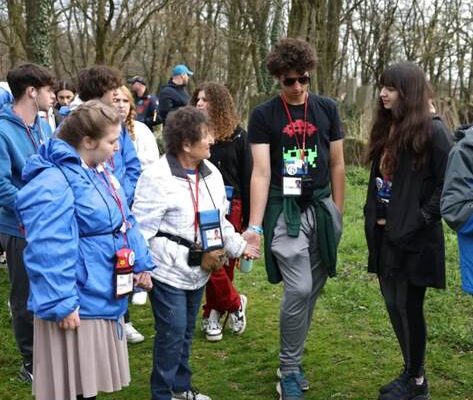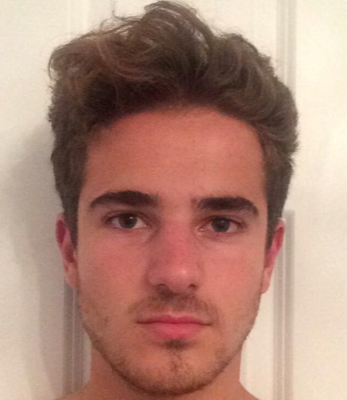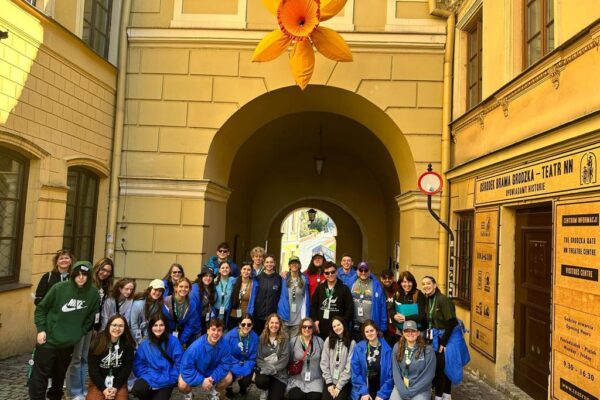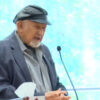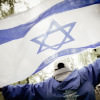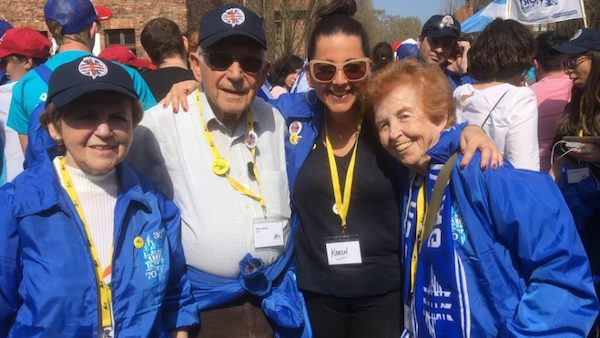
Karen (second from right) with survivors Mala Tribich , Eve Kugler, Harry Olmer, at Auschwitz during March of the Living
Karen Pollock, Chief Executive of the Holocaust Educational trust, was part of the 275-strong UK’s delegation to Poland for March of the Living, as more than 11,000 came together at Auschwitz to remember six million Jews.
Following an emotional week of learning about Jewish history and Polish-Jewish life, she reflects on what
Sunday 8th
I felt nervous setting out on the March of the Living. Working at the Holocaust Educational Trust, I have visited Holocaust sites with thousands of teachers and students but I did not know quite what to expect. But I was looking forward to being amongst Jewish people from across the world.
We started in Warsaw at Okopowa Cemetery. There we saw Jewish graves dating back to the 1800s, the mass graves of those murdered by the Nazis and tombstones of Jews who died after the Holocaust. Seeing the story of Jewish life played out within this burial site left a poignant mark on us.
We visited the Polin Museum, documenting the history of Polish Jews in Warsaw. Its Chairman, Marian Turski, who endured Auschwitz, Buchenwald, Rehmsdorf and a death march to Thereisenstadt, told us that after the war he dreamt of building a museum to celebrate centuries of Jewish history in Poland. What an achievement.
Finally, we learnt about the Oneg Shabbat – to see one of the milk churns buried beneath the Warsaw Ghetto, full of stories of life in the ghetto, was incredible. These brave people took enormous risks to record their experiences for future generations, showing unimaginable defiance and bravery.

Karen at the remaining Warsaw Ghetto Wall
Monday 9th
Today, we visited Majdanek where 59,000 Jewish men, women and children were murdered. Majdanek is a chilling place, just in the suburbs of Lublin.
We saw the gas chambers and the incredible memorial containing the ashes of some of those who were murdered. You can’t stand in such a place, so close to the town, without considering what the outside world knew of the horrors taking place as they went about their daily lives.
Our day ended at Lublin’s Yeshiva and together we remembered Alec Ward, an amazing survivor born in the town, who passed away over Pesach.

Holocaust survivor Arek Hersh photographed in Majdanek-
Photo by Sam Churchill for MOTL UK
Tuesday 10th
Today we visited Belzec. At least 434,500 Jewish men, women and children were murdered here in a matter of months. They were forced down a narrow, camouflaged path to their deaths, unaware of what was to come. As we walked, I felt palpable fear for those who had walked that same path. But I was able to walk out.
In Markowa, we heard the story of Jozef and Wiktoria Ulma, devout Catholic Poles, who risked everything to harbour a Jewish family. They were discovered and shot, alongside their 7 children.

Belzec Death Camp
Photo by Sam Churchill for MOTL UK
And we saw the forest outside Tarnow where 45% of the village was slaughtered and buried in pits.
Throughout the Holocaust across eastern Europe, there were massacres in fields, forests and ravines by German SS and police units or by local collaborators. There was no dignity for these Jews slaughtered and left in unmarked mass graves.
It was a difficult day that I will never forget.
Wednesday 11th
As the sunset, Yom HaShoah began.
We took part in a ceremony at the Galicia museum, remembering the 6 million Jewish men, women and children murdered and reaffirming our dedication to saying Never Again.
Thursday 12th
The March.

Scott Saunders, chair of March of the Living UK, stands in Auschwitz ready to lead the UK delegation on the 1.5 mile march
It is impossible to understand the Holocaust.
The more we learn, the more questions we have.
On this trip, we learned about those who risked their own lives to help Jews, we also learned about those who with a flick of a finger decided life or death.
This week was often painful, but as we marched and as we stood amongst thousands of Jewish people from across the globe, singing Hebrew songs, draped in Israeli flags, the experience was uniquely moving and uplifting.

Karen with Emma and Tamara, granddaughters of David Herman and Jack Kagan, respectively.
I stood shoulder to shoulder with Holocaust survivors, Mala Tribich MBE, Eve Kugler, Harry Olmer, and Ivor Pearl; Jewish students from youth movements and universities across the world and champions of our cause Sir Eric Pickles, Ian Austin MP and Joan Ryan MP.
As we marched the 4km from Auschwitz I to Auschwitz-Birkenau, I remembered the words of survivor Harry Spiro: “Hitler you didn’t win”. And that’s what I thought as we walked the path of those who had been sent so brutally to their deaths.
This visit focused on loss and destruction, as the Jews of Europe were ripped from their homes, families torn apart and finally, murdered. But today, as we came together to remember, and to mourn, we also thought of our hope for the future.
Originally published HERE
